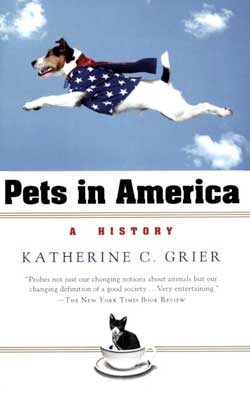
Book Review
Pets in America: A History
Chapel Hill: University of North Carolina Press, 2005
vii + 392 pages. Illustrations, acknowledgements, notes, and index
$34.95 (cloth), ISBN 0-8-0782990-5
I went to England for several weeks during the summer of 2006 on an architectural-study tour. While I was gone my wife and children, upset that I had taken all of our vacation time (and vacation money), kept threatening that they were going to buy something really extravagant to get back at me. What they bought was a little full-bred Yorkshire Terrier that they named Attingham. I returned to find a new small puppy, with a huge sticker price, that is not happy unless he is on someone’s lap. He even sleeps in our bed each night, inevitably lying next to my head. Of all the things they could have bought, why a new pet?
Katherine Grier’s recent book, Pets in America, answers my question. Grier provides an historical explanation for our fascination with the house pet. Her book is a fantastic study of American culture and is easily readable and entertaining. Each chapter is dedicated to a particular theme, and though they work together, they are meant to be read “individually, as topical essays” (11). Chapter One describes the array of pets available throughout history; Chapter Two, family rituals of pet ownership; Chapter Three, the domestic ethos of kindness; Chapter Four, pet keeping; Chapter Five, the live animal trade; and Chapter Six, pet supplies and pet stores.
Pet-keeping developed from the sixteenth- and seventeenth-century fascination with natural history. Pets came to America with the first colonial settlers. Keeping birds, squirrels, and small dogs was a routine part of colonial life. But the practice of keeping pets in the “home” was a Victorian invention and is the subject on which most of the book focuses.
Grier approaches this study with a background in Victorian domestic culture. This makes her observations about pets keenly fascinating. Showing how pet ownership stemmed from the “domestic ethos of kindness,” she adds an intriguing and insightful origin to pet ownership that allows a since of continuity between Victorian domestic culture and child rearing today. This point can not be overstated, as Grier shows that the pet, as a living object, was part of the material culture of the Victorian home.
Between 1840 and 1940, a nationally marketed pet industry developed in the United States that commodified this domestic ethos of kindness. When people bought a pet they were, in fact, “buying a relationship,” one that offered “post-purchase maintenance” (231). Prior to commodification, the maintenance required--in the case of dogs and cats--specifically prepared foods in the form of special stews and puddings made from table scraps or “dog meat” and “cat meat” from a local butcher (84). Prior to the commodification of the industry, people typically had acquired pets from the offspring of the pets belonging to family or friends. But by the middle of the nineteenth century, “small animals were also the objects of a slowly growing commerce supporting a community of entrepreneurs who often combined trade in animals with other kinds of work” (232). In the 1890s, the modern pet store could be seen in most major cities, supplying the animal and special supplies needed to care for an ever increasing range of small “pet stock” animals. This trade in animals grew, and as “consumers became more interested in European breeds and purebred dogs, some dog dealers became respectable importers,” as well (232). By the 1920s, the Victorian ethic of kindness, using pets to teach children kindness, became a consumer driven enterprise marketed to sell a “pet to every home” (233).
The book is full of narrative stories that make the work easy to read and popularly accessible. This is often the focus of most reviews, but frankly, this is not the importance of the book from a historiographical perspective. The book derives its importance from the themes presented above. The pet was firmly tied to domestic culture and the house, as an artifact of that culture. This association with the home is why we still have “household” pets today.
Pets in America is an excellent model of the diverse application of material culture studies. But Grier also provides a model I wish were duplicated by more authors of material culture. Grier acted as curator for an associated exhibit entitled “Pets in America.” This exhibit featured the artifacts and advertisements and places her historical research in a publicly accessible venue. The exhibit was created at the McKissick Museum at the University of South Carolina and will be traveling through 2008.

